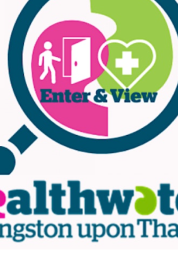Including Digitally Excluded Communities: Engagement Report

Download the report
This ‘Including Digitally Excluded Communities’ report shares findings from our community engagement with Kingston residents. Healthwatch Kingston listened to 137 people (95 digitally excluded and 42 young people) who contributed their views and experiences in different ways. Our focus was to find out how Healthwatch Kingston could better engage people who were digitally excluded in our work and, how they might better access information about health and social care services. What we were told confirmed that “one size does not fit all” and, as a ‘digital first’ borough, it is important that all of us hear what people have said.
Listening to digitally excluded communities has reminded us:
- To not assume our usual methods of engagement (such as virtual meetings and attendance at public events) will be appropriate for all of our community activities.
- To ensure co-preparation/design/production/delivery of engagement plans with target groups and other relevant stakeholders.
- Outreach is the best way to meaningfully engage with some of our communities (e.g. face-to-face “we’ll come to you” focus groups and follow-ups). But it is resource intensive (co-preparation etc., engagement, collation, analysis, reporting, follow-up with groups to give feedback).
- To be inclusive, there is a need for engagement tools and health and social care information in ‘Plain English’ and other languages and in formats that meet the ‘Accessible Information Standard’ so that people with a disability or sensory loss are given information they can understand, and the communication support they need.
- To respectfully feedback to digitally excluded communities we need to use a range of methods (such as returning to community groups we engaged with, ‘you said we did’ style posters/presentations/reports, telephone, audio and printed newsletters).
Healthwatch Kingston re-commits to improve our engagement with digitally excluded communities and, in order to feedback the findings from this community engagement to participants the way we have been asked, we will:
- Work with the Royal Borough of Kingston upon Thames Involve team of learning disability advocates to produce a Plain English/Easy Read version of this report
- Work with Kingston Association for the Blind to create an audio recording for people who are blind or have sight impairment
- Re-visit each digitally excluded group we engaged with to deliver ‘you said we did’ presentations and share information in accessible formats.
To standardise our approach across communications and engagement professionals, we will also explore co-producing an including digitally excluded communities’ engagement toolkit with communities and other stakeholders.
Recommendations about how communications and engagement professionals can better engage digitally excluded communities in our work and how people can better access information about health and social care services:
- Healthwatch Kingston recommends that communications and engagement professionals, planning to meaningfully engage with digitally excluded groups, allocate resources to support face to face outreach. This needs to include time to co-design accessible information that supports appropriate delivery and follow up with target groups (and as necessary, their families/friends/carers), so groups can engage in ways that suits them (such as advertising in the talking newspaper for people who are blind or vision impaired, “we’ll come to you” meetings and easy read and audio reports etc.).
- Healthwatch Kingston recommends that communications and engagement professionals, planning to meaningfully communicate and engage with digitally excluded groups, ensure adherence to information in ‘Plain English’ and other languages, and in formats that meet the ‘Accessible Information Standard’ so that people with a disability or sensory loss are given information they can understand, and the communication support they need. Communications and engagement professionals should also consider engaging the ‘Plain English Campaign’ to review their organisation’s website, approve and then maintain annual accreditation of the Internet Crystal Mark that shows it is clear, well-designed and accessible.
- Healthwatch Kingston recommends that communications and engagement professionals, consider how NHS and social care services can regularly promote the statutory service function provided by Healthwatch Kingston in their public meeting presentations, in health and care locations (such as General Practice waiting rooms) and as part of patient and service user information (e.g. hospital patient discharge packs).
- Healthwatch Kingston recommends that communications and engagement professionals, if hosting a meeting, consider the suitability of the engagement room, as fluorescent lights, outside noise/noise in the room, can be a particular challenge for neurodiverse people with audio processing disorder.
- Healthwatch Kingston recommends that communications and engagement professionals refer to ‘recommendation 3’ (page 5) in our ‘Including Communities’ report which reads: ‘SWLICB and Kingston Place leads to ensure core and targeted health and care information, education, promotion and engagement is available in relevant languages for RASM, also in accessible formats for people with disabilities, the digitally excluded and other seldom heard from communities.’
- Healthwatch Kingston recommends that communications and engagement professionals refer to ‘recommendation 3’ (page 5) in our ‘Including Communities’ report which reads: ‘SWLICB and Kingston Place leads to ensure core and targeted health and care information, education, promotion and engagement is available in relevant languages for RASM, also in accessible formats for people with disabilities, the digitally excluded and other seldom heard from communities.’
- Healthwatch Kingston recommends that SWL ICS and Kingston Place leads explore ways to ensure services are informed that people are blind or partially sighted.
Healthwatch Kingston would also like to request the following updates:
An update from RBK about what plans are in place to continue to help digitally excluded people through the ‘Empowering Residents Through Digital Inclusion’ project and what support is being provided to people that have completed the project to help them embed their new digital skills and continue to access the benefits that technology can provide.
An update from SWL ICS about how support for digitally excluded people, identified in the ‘SWL ICS Strategy and NHS Joint Forward Plan Insight from people and communities’ report (published in March 2023) has influenced the SWL ICS Digital Inclusion Strategy.

